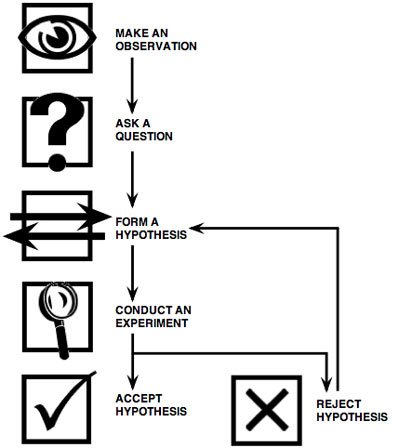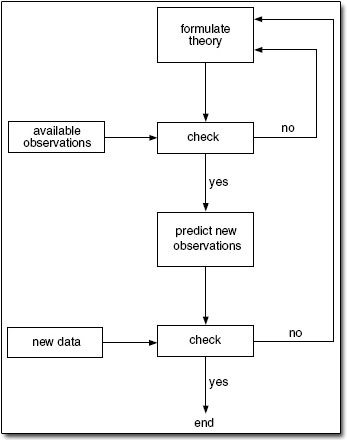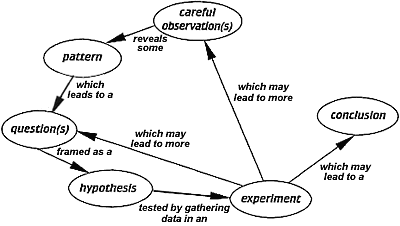 | AN OUTLINE OF THE SCIENTIFIC METHOD |
The scientific method is a systematic process of empirical investigation. Empirical means using the senses: science is based on what we can concretely observe with our five senses - http://scene.asu.edu/habitat/s_method.html |
The major difference between the scientific method and the inquiry process is that the inquiry process provides more opportunities to move within and among the phases of the inquiry (problem-solving process). - http://www.k8accesscenter.org/training_resources/ScienceInquiry_accesscurriculum.asp |
How the Scientific Method Works - http://science.howstuffworks.com/scientific-method.htm/printable |
|
Applied Management Science - http://home.fit.ba/ntsbarsh/Business-stat/opre/opre640.htm |
Managing complexity: a systems approach ¢ introduction - http://labspace.open.ac.uk/file.php/3422/formats/print.htm |
http://www.birds.cornell.edu/schoolyard/Research/scientific_method.html |
Science is the study of the world around us. That world can be large, like the oceans, or very small, like genes. Scientists, like everyone, use their senses of sight, hearing, touch, smell, and taste to explore and observe things in the universe that interest them. Even astronomers who study galaxies far away use their senses; they are just amplified using technology like telescopes. Observations lead to questions, hypotheses, experiments, and usually more questions.
The Scientific Method
Explore/Observe
Ask a Question
Formulate a Hypothesis
Design an Experiment
Reflect on the Results
Sample Experiments
The Scientific Method
We want your students to understand that science is not some magical process, but actually an everyday one in which systematic steps are taken to answer questions.
The following steps describe the basic method by which all scientists try to find answers to their own questions:
They observe natural process until they think they see a pattern in the events they are observing.
They define questions to investigate based on their observations. These questions often arise from findings of earlier research or even research done by other scientists (and citizen scientists).
They develop hypotheses (testable guesses) to try to answer their questions.
They systematically collect and then analyze information (data) to test the hypotheses.
They look at the results, then come to conclusions about whether their hypotheses are correct (supported or not supported). Often, they ask even more questions based on what they have observed.
For example, marine science is the process of discovering unifying principles in data obtained from the ocean. Marine science is interdisciplinary, which mean that it draws from many areas of scientific inquiry. Science is a systematic process of asking questions about the observable world by gathering and then studying information (data), but information itself is not science. Science interprets raw information by constructing a general explanation with which the information is compatible. Marine geologist: the composition of inner Earth, the characteristics of seafloor sediments, and the history of layers.
Scientist starts with the question ¢ a desire to understand something they have observed or measured. They then form a tentative explanation ¢ a working hypothesis, a speculation about the natural world that can be tested- for the observation or measurement. The hypothesis can be verified or disproved by further observations and controlled experiments. An experiment is the test that simplified observation in nature or in laboratory by manipulating or controlling the conditions under which the observations are made.
So: Observations, measurements
Hypothesis
Experiments
Theory
Law
Curiously
Observations
The external world, not internal conviction, is the testing ground for scientific beliefs.
The process of "doing science" takes both logic and creativity. That statement surprises many non-scientists. While objectivity is certainly important to the scientific process (being able to distance yourself enough to get accurate information), so is ingenuity. Many people picture scientists as rigidly logical, one-dimensional beings who spout lots of jargon (okay, we don''t help our own image sometimes!). In reality, though, like in business and other fields, being able to "think outside the box" is crucial in science. It''s how progress occurs. Consider the scientific method as you read your textbook. All of the information in your book has been obtained by scientists following the scientific method, in a dynamic, creative process that builds on past knowledge while exploring new terrain.
Science is a systematic process in which observation of the natural world leads to questions, and possible answers to such questions are proposed and tested. This process of questioning and investigation is known as the scientific method. The steps in the scientific method are as follows:
Observe. The process begins with the observation of some phenomenon in the natural world. Observations must be occurrences that we can see, feel, hear, touch, smell, or measure using scientific tools (like telescopes or microscopes). Anything that cannot be directly observed in this way is outside of the realm of science.
Formulate a question. This is the step that logically follows an observation that cannot be readily explained. It usually takes the form, ōI wonder ifģ.?ö, or ōCould it be becauseģ.?ö
Research the known facts. Often, it is not necessary to start at square one when investigating a problem. Some questions that result from observations will have been investigated many times before, and you can use that information to answer your question, or help focus your next step in this process.
State a hypothesis. A hypothesis is a tentative, testable statement relevant to answering the question you have asked about the phenomenon you observed. The key part of this definition is testable. If a hypothesis cannot be tested, it is not scientifically useful, no matter how interesting it might seem.
Test the hypothesis. This step involves the development of observations, experiments, and models to test whether or not the hypothesis correctly explains all observed cases, and can be used to correctly predict future outcomes. An important feature of such testing is that it must be repeatable, not just by the original experimenter, but by others. Hypotheses are usually tested many times.
Accept, modify, or reject the hypothesis. Many hypotheses are correct, and many are wrong. Proving a hypothesis wrong is not a scientific failure. Even hypotheses that are initially accepted must often later be modified, or even totally rejected, when new observations come to light. It is only after extensive testing that a hypothesis is elevated to the next level.
A hypothesis that has undergone extensive, rigorous testing may be advanced to the status of a theory, a statement or relationship that is accepted by most scientists. Examples would be the theories of evolution and plate tectonics. It is a common misconception on the part of non-scientists that the word ōtheoryö implies a highly speculative, tentative concept (i.e., just a ōguessö). On the contrary, a hypothesis only becomes a theory after years of testing and verification. The highest status a scientific principle can achieve is a law. Laws are principles explaining events in nature that have been observed to occur with unvarying consistency. Examples would be the laws of motion and thermodynamics in physics.
In practice, one of the most important skills one needs for analyzing scientific research is to be able to distinguish between the observations a scientist makes (data) versus the interpretations that he or she draws from those observations (hypotheses):
Good observations are unbiased and are reproducible. Scientists, however, may have several different "working hypotheses" to explain one set of observations and as new data are collected, hypotheses often change. This is absolutely alright -- it''s how science advances. "Good data are immortal" (i.e., once an accurate observation is made, it should never be dismissed); hypotheses involve interpretation and can change as new data are introduced. Sometimes what''s needed is to puzzle over carefully collected data and "unlearn" inaccurate or incorrect assumptions and interpretations.
Good hypotheses aren''t necessarily "the right answer", and that''s totally fine! There can be multiple, equally reasonable explanations for a given set of data. Good initial hypotheses lead to new-and-improved hypotheses, perhaps more focussed or more comprehensive. A hypothesis should generate a set of predictions whereby we can formulate tests of the hypothesis.
Many times the media writers (in contrast to scientific writers) do not make this distinction -- For better readability, sentences in articles for the "lay public" often contain both observations and interpretations, and it''s up to you to figure out what are the data and what are the interpretations. Therefore, it is important for you to be able to distinguish between observations and interpretations. In this assignment, you''ll do this by making observations and interpretations of your environment.
Does science ever arrive at the undisputed ōtruthö? Any scientist who makes such a dubious claim should be considered misguided. Absolute truth is not a reachable goal in science, because we can never be sure that we have acquired and fully examined all available data. And that is fine! No rational scientist will ever claim that he or she has enough data and needs no more. It is even possible that well-accepted theories and laws may be superseded by new observations that are not yet available. This should not, however, be looked upon as a weakness of science. Instead, it is a great validation of the strength of the scientific method. Many of the greatest scientific advancements in history have been the result of new observations that caused a previously accepted hypothesis to be rejected.
Formulating Good Questions -- Go Outside!
Perhaps the hardest task for any scientist is to ask a good question. As Sean Chamberlin points out in "The Remarkable Ocean World": "A properly posed scientific question gets to the root of the matter; the mere creation of it suggests possibilities we might never have considered; the asking of it illuminates gaps in our knowledge and exposes those parts of a problem that are most critical."
Now it''s time to put the concepts above into practice, and explore first-hand the art of scientific thinking. You can do this activity in the mountains, at the beach, in a park, in your back yard... pretty much anywhere outside "in nature". As this is a science class, the questions must be about scientific subjects/observations.
Go outside. Look around you. Make careful observations. What do you see? What kinds of phenomena define the landscape? the coast? the mountains? What kinds of organisms or materials travel along or within the rivers or beach? What kinds of things can''t you see that you might be curious about? Don''t limit yourself or your thinking. Stretch your mind. Include the land, the sky, the sea. Observe the big picture as well as the tiny picture.
Write your observations in the form of questions. Write at least twenty (20) questions. The reason twenty is important is because it forces you to observe and think! At about 12 or 13 questions, you run out of the obvious questions and then you really have to start looking around you. Try this little test on your questions: Ask yourself if the question would be easy to answer through experiment or further observation. If not, try to think of a way to ask the question that might make it easier to answer. [Example: Instead of asking ōWhy does the ocean look blue?ö, you might phrase your question ōDoes the fact that the ocean appears blue have anything to do with the sky being blue?ö]
Pick one of your questions above, and try to form several possible answers (that is, several proper scientific hypotheses). Remember that a proper hypothesis must be testable. [Example (continued from above): ōHypothesis: The ocean appears blue because the light reflected off of it to our eyes comes from the blue sky.ö (By the way, this hypothesis is not correct, but thatÆs okay!)]
For each of your hypotheses above, list several predictions that might be true if the hypothesis is true. What do you expect to see based on the hypothesis? [Example (continued from above): ōOn a cloudy day, the ocean will not appear blue.ö]
Scientific Method Assignment
Scientific Method and Researching
Earth Science Curriculum
Science and ways of knowing
Method First, Result Later






